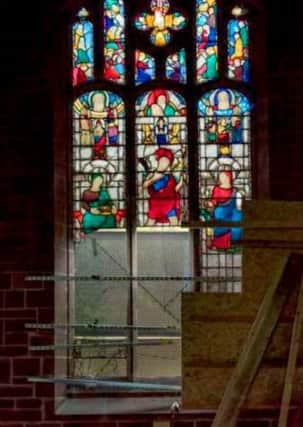Vandals wreck historic window by '¨stained-glass artist from Belfast


She was surrounded by three tall, slender, radiantly-hued windows depicting scenes based on Psalm 100 - ‘For the Lord is good; his mercy is everlasting and his truth endureth to all generations.’
Wilhelmina wrote in her diary on July 27, 1935 - “traceries almost complete.”
Advertisement
Hide AdAdvertisement
Hide AdOn a later page on 26 September, her postscript to the stunning two-year commission confirmed that the windows had gone to Egremont Presbyterian Church in Wallasey, near Liverpool.
But 82 years after she noted that her richly luminous glasswork was almost finished, her now terribly neglected windows have been further violated.
Award-winning biographer Dr Nicola Gordon Bowe e-mailed the bleak news to Roamer - “as for Geddes, she’s been having a rough time in Wallasey where vandals broke into the sadly now-abandoned Egremont Church using her window as their point of entry. As you’ll see from the attached photograph, the lower part of the window is in smithereens.”
An address about her Psalm 100 masterpiece, given in the church in 1938, explained that Geddes’s windows depicted “as many representatives of as many tribes and nations as could be contained in the limited space.”
Advertisement
Hide AdAdvertisement
Hide AdThe speaker summarised Wilhelmina’s unmatched artistry adorning the church’s walls - “There are fifty-two figures, seven animals and birds, the founders and heads of all the early Biblical tribes and peoples are featured. Blue sky with stars in the background are intended to remind us of God’s promise that the seed of Abraham should be as numerous as the stars.”
With a substantial section of the window missing and infilled with reinforced Perspex, the boarded-up remainder is a tragic reminder of Belfast’s often-forgotten but uniquely talented genius.
After her death in 1955 Geddes was described as “the greatest stained-glass artist of our time.”
Two decades earlier, with the Egremont window completed, she immediately embarked on the largest, and one of the most famous, windows that she would ever make, the 250-square-feet, 25-feet-diameter rose window commemorating Belgian King Albert I, in the rebuilt Cathedral of St Martin in Ypres.
Advertisement
Hide AdAdvertisement
Hide AdIt was based on the early Christian hymn Te Deum - ‘Thee, O God, we praise’.
Headlined ‘Belfast Artist’s Success’, the Belfast Telegraph reported on Saturday, May 7, 1938 “this splendid window...including 48 figures about half life-size. Prophets, Apostles and Martyrs surround a central panel representing Christ, with attendant angels and various symbolical figures. Forty smaller panels are filled with angels and heraldic devices.”
In her biography of Geddes, Nicola Gordon Bowe writes that the window was dedicated to King Albert’s son Leopold “who succeeded his father as King and Colonel-in-Chief of the 5th Royal Inniskilling Dragoon Guards.”
The Inniskilling’s Journal “heralded the event more accurately” Nicola explained.
Advertisement
Hide AdAdvertisement
Hide AdWilhelmina’s magnificent Ypres window contained 62 figures, not 48!
Born in 1887 in Leitrim, Geddes’s parents moved to Belfast when she was two years old where she and her three younger siblings were raised as strict Methodists in a succession of houses between the Lisburn and Malone Roads.
Aged just 16 Wilhelmina began her art studies in Belfast Municipal Technical Institute where she excelled over the next eight years.
Though unusually talented in almost every art and craft, she focused on her great love - stained glass.
Advertisement
Hide AdAdvertisement
Hide AdGeddes’s first two full-scale windows, completed in 1912, are both in Co Fermanagh.
Her Angel of Resurrection: ‘Why seek ye the living among the dead’ is in St Ninnidh’s Church of Ireland, Innishmacsaint and Innocence Walking in the Fields of Paradise is in St Molaise’s Church of Ireland, Monea.
Wilhelmina’s richly coloured windows are in many other buildings - some here, some in the Ulster Museum’s store rooms, and others in distant places.
Along with some of history’s greatest artists, musicians and writers, a crater on the planet Mercury has been named after her.
She won prizes.
She received glowing reviews for her work.
Advertisement
Hide AdAdvertisement
Hide AdThough suffering greatly both physically and mentally she benefited from numerous commissions for stained glass memorial windows in the wake of WWI.
Her Ottawa Memorial Window (1917-19) representing a slain warrior being greeted by military saintly heroes in heaven “incorporates consummately painted figurative images from legend and the Bible to personify the tragedy of loss,” writes Nicola Gordon Bowe in her biography.
Nicola and other Geddes-enthusiasts are campaigning tirelessly on behalf of the beleaguered Egremont window.
Much of the coloured glass thoughtlessly splintered by vandals has probably been lost for ever, and though an alarm has been installed, the unused and now privately-owned church and its remaining windows await an uncertain future.
Advertisement
Hide AdAdvertisement
Hide Ad“Her work does get so badly treated,” mourned Nicola’s e-mail to Roamer.
There are windows in the Egremont building by other stained-glass artists as well as Wilhelmina Geddes.
Nicola commends them as “exceptionally good” her e-mail ended “but none beats hers.”
Full details on Wilhelmina Geddes: Life and Work, the award-winning biography by Dr Nicola Gordon Bowe, are on www.fourcourtspress.ie